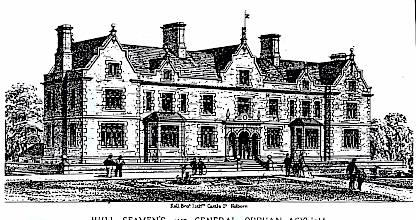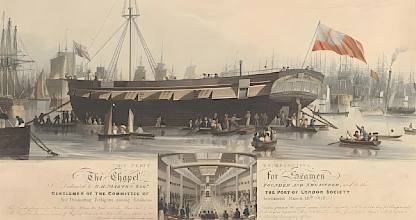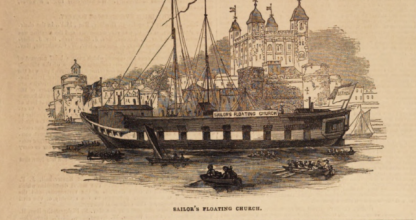
Seamen’s Orphanages
Working seamen lived dangerous and peripatetic lives which left families and dependants unprotected. Orphanages were created to provide opportunities for those left behind.
Japanese Seamen’s Home
In 1903, a new Japanese Seamen's Home was opened by the Bishop of Osaka at 31 Elizabeth Street, North Woolwich, near the Royal Albert Docks.
Reverend E. B. Bhose and the St Luke’s Lascar Mission
Find out more
Laying of the Foundation Stone: Strangers’ Home for Asiatics, Africans and South Sea Islanders.
The foundation stone for The Strangers’ Home for Asiatics, Africans and South Sea Islanders was laid by Prince Albert on 31 May 1856.

Port of London Society
The Port of London Society (PLS) was founded in London following a meeting held at the City of London Tavern on Thursday 5 February 1818, ‘to consider the best means for affording religious instruction to British Seamen while in the port of London’.

Seamen’s Christian Friend Society
The Seamen’s Christian Friend Society (1848) had its origins in the ‘Thames Revival’ which emerged among common seamen around the Port of London on the final years of the Napoleonic wars.

Episcopal Floating Chapel Society
The Episcopal Floating Chapel Society was the first attempt by the Church of England to provide a maritime church in the Port of London.

Merchant Seamen’s Bible Society
The Merchant Seamen's Bible Society was founded in 1818 to supply British merchant ships with copies of scripture.

London Sailors' Home
The London Sailors’ Home was the first short-stay, purpose-built home for sailors, and it set the model for scores of others that followed in British and colonial port cities.

St Andrew's Waterside Church Mission
St Andrew's Waterside Church Mission was a high church mission at Gravesend catering not just for seamen but fishermen and emigrants.
Port of London
Throughout the long nineteenth-century London was a key sight for mission activity to Asian sailors. This included London Strangers’ Home for Asiatics, Africans and South Sea Islanders and the Society for the Protection of Asiatic Sailors.
The West India Dock Act of 1799 signalled the construction of the West India Docks, completed in 1802. Financed by the West India Dock Company, the eventual cost of which came to over one million pounds, they were the first of the great docks built in nineteenth-century East London.
Surrounding areas like the Limehouse district were consequently populated by maritime labour. Many of these individuals were lascars, sailors predominantly from South Asia, but also Africa and the Middle-East. Living London, an illustrated book with various chapters recounting the city’s sites, scenes and communities published in 1902, was rooted in racial, class and Nationality stereotypes and prejudices. It provides a glimpse of how many onlookers perceived this area. The author wrote, ‘It is in the crowded thoroughfares leading to the docks, in the lodging houses kept by East Indians, in the shops frequented by Arabs, Indians, and Chinese, and in the spirit houses and opium smoking rooms that one meets the most singular and most picturesque types of Eastern humanity, and the most striking scenes of Oriental life.’
Like the author of Living London, many social reformers, official bodies and religious organisations saw Limehouse as a source of great fascination and concern. A number of religious organisations also observed how lascars that awaited their return passages in London, were ill-treated, impoverished and neglected.
The largest and most famous organisation that responded to these issues was the Stranger’s Home for Asiatics, Africans and South Sea Islanders. Opened by Prince Albert on 31 May 1856, the Home was a product of intersecting but varied interests. The initiative to establish the institution was spearheaded by the secretary to the Church Mission Society, Henry Venn, and it received essential financial backing from Queen Victoria and Prince Albert, who donated £200 and £100, respectively. The greatest donation, however, was provided by the last maharaja of the Sikh Empire, Duleep Singh, a recent convert to Christianity. The Home opened in June 1857, just a year after the laying of the foundation stone, and had dormitories to accommodate 220 people, a depository where the men could store their valuables, a dining hall, bathrooms and laundry rooms. Additionally, the institution contained its own Lascar Shipping Office where records of unemployed sailors were kept, and lascars’ work contracts with shipping companies were organised and negotiated.
A Shipyard on the Thames, John Cleveley the elder, 1769. Glasgow Museums Resource Centre (GMRC).
Armfelt, E. 1902. 'Oriental London' in George R. Sims (ed.) Living London Vol. I (London) p. 83.
Garcia, Humberto. 2022. 'The Strangers’ Home for Asiatics, Africans and South Sea Islanders: Inaugurating a Hospitable World Order in Mid-Victorian Britain', Global Nineteenth-Century Studies 1.1 (2022), pp 81-90.
Salter, Joseph. 1873. The Asiatic in England: Sketches of Sixteen Years' Works Among Orientals (London: Seeley, Jackson, and Halliday).
Salter, Joseph. 1896. The East in the West; or, Work among the Asiatics and Africans in London (London: S.W. Partridge & Co.).
www.layersoflondon.org/map/records/west-india-docks-canary-wharf
Lucy Wray, 'Port of London' Mariners: Race, Religion and Empire in British Ports 1801-1914, https://mar.ine.rs/where/london/
Retrieved 19 May 2024
Timeline Filter
Where Filter
Who Filter
What Filter

























